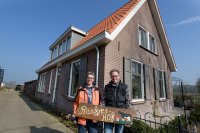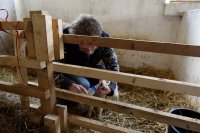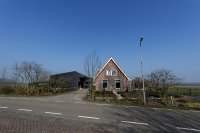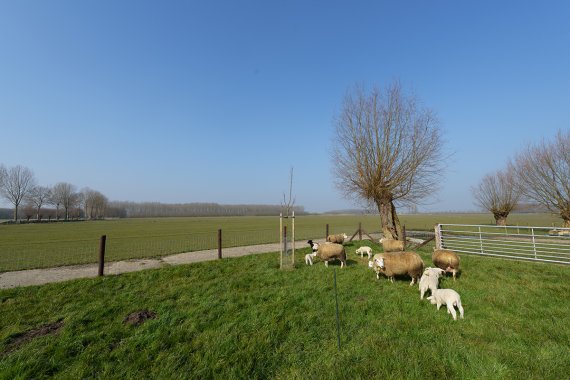Photos Guy Ackermans
The view out of the kitchen window of Raafjeshof Farm on the Kooiweg-Oost is spacious. Meadows as far as the eye can see, with a ditch here and there. ‘It used to look very different,’ recalls Marien Borgstein. ‘The meadows were bordered by a lot of pollarded willows.’ He should know because he grew up here.
And now Borgstein has been back in his parental home for a couple of years. Starting a new career as a sheep farmer and combining that with taking care of his elderly parents. The surroundings have changed considerably and yet it still feels like home. ‘It’s still the same place. I’ve been away for 30 years but half the people I knew then still live here. I’m a country boy. I like being out of doors with animals around me. And I had a good time here.’
Green Deals

Marien Borgstein en zijn vrouw Puck Bonnier: ‘De meerwarde van ons bedrijf zit ‘m in de kleinschaligheid en het dierenwelzijn.’
Borgstein comes from a farming dynasty. His grandfather had an urban farm in Culemborg with a farm shop. ‘At the end of the 1960s – when I was two and a half – we moved out into the country. He shows a photo. On the left side of the gable of a modest little house hangs a sign: Raafjeshof. ‘Named after the Frisian cow Raafje 2, the first cow on my father’s farm to produce 100,000 litres of milk. That was quite something in those days – 1986! Even the local councilor came by.’
Marien Borgstein studied Agricultural Economics in Wageningen and then went to work for the LEI in The Hague. He still works there as a qualitative researcher, one of his topics being the development of rural areas through ‘Green Deals’ for nature and recreation. Projects such as that of the Schöndeln country estate near Roermond, where hitherto inaccessible farmland has been turned into a public nature reserve. Limousin cattle provide natural grazing and their meat generates income. There is a nice word for this approach: a nature-inclusive economy. Borgstein: ‘How can you weave together nature and economic activity in a business model which ensures that nature too benefits and biodiversity increases. I supervise those processes.’ Eight trial projects have been established.
Lamb chops

So Borgstein is no stranger to entrepreneurship. But to go into business himself? It certainly wasn’t a long-cherished wish. ‘In that sense I’m not such a planner,’ he says. ‘I am enterprising though. I always try to make something of whatever crosses my path.’
Which doesn’t mean of course that the idea of returning to Culemborg and becoming a part-time farmer came out of the blue. ‘My wife and I had sometimes said it would be nice to live in the countryside with the children. We were living in a little neighbourhood in Haastrecht.’ In 2014 the time was ripe. His father’s cattle farm had gone out of business in 2000. The farmhouse was thoroughly renovated and extended, and Borgstein’s parents, now 80 and 86, moved into the adjoining residence.
‘The houses are connected but they can still live there fully independently. Their care needs are still quite minimal at the moment. Of course that can change suddenly but I don’t worry about that now. Take it as it comes. They both come from a strong line.’
Borgstein took over the 30 sheep (his father’s hobby) last year as well, to start up his business with. In the same year 50 lambs were born: 30 ewes and 20 rams. The rams and some of the ewes were slaughtered and the meat was sold. The sheep farm is to start this year with 50 ewes, which are expected to bring nearly 100 lambs into the world. Each lamb produces about 20 kilos of meat; chops, legs of lamb, mince etc, sold in packets of 5 to 10 kilos. ‘So if a couple of hundred colleagues all want to buy a packet, I’ve come full circle,’ jokes Borgstein. The entrepreneurial spirit is alive and well.
Short Chain
 And so the researcher who helps others come up with business models suddenly finds himself in the role of small-scale entrepreneur. Without a real business plan, without any market research. Borgstein acknowledges that it’s all learning by doing with him. ‘But we have given careful thought to storage and buyers, you know. This isn’t just a hobby. You spend money on a hobby. This is supposed to generate some income; that is the starting point. In the first instance you look for your market close by, among friends and family. Now we are at the stage of widening the circle, for instance to catering outlets in the Betuwe. As well as a Facebook page
And so the researcher who helps others come up with business models suddenly finds himself in the role of small-scale entrepreneur. Without a real business plan, without any market research. Borgstein acknowledges that it’s all learning by doing with him. ‘But we have given careful thought to storage and buyers, you know. This isn’t just a hobby. You spend money on a hobby. This is supposed to generate some income; that is the starting point. In the first instance you look for your market close by, among friends and family. Now we are at the stage of widening the circle, for instance to catering outlets in the Betuwe. As well as a Facebook page
, I’ve got a flyer that I leave in all sorts of places in the area. I am exploring the home market.’
Raafjeshof Meat, as it is called, is a textbook example of a small chain, with zero links between producer and customer. ‘The added value lies in the small scale and the animal welfare,’ says Borgstein. ‘The consumer knows that the animals are treated with respect. The sheep are slaughtered by a local butcher just a few kilometres away so they are not carted about all over the place. The margin stays entirely with the producer.’ But the small scale has its limitations too. ‘You can spread your costs over fewer kilos.’ That is why Borgstein only sells meat in packages of 5t to 10 kilos. ‘Because the smaller the packages, the more the customers and the work.’

His business comes in useful for his work as an applied researcher. ‘I have a better understanding of entrepreneurs now; I can put myself in their shoes more easily. Being in business yourself gives you a different perspective on things.’ Because it’s one thing to start up a small-scale enterprise, but how do you take it from there? ‘Storage and transport are challenges. The work is manageable so far, because we have jobs for four days a week. We do this on the side. But what if you want to upscale? Is it really viable then? We should actually keep track of our hours properly.’
Email Marie Borgstein for more information: marien.borgstein@gmail.com

